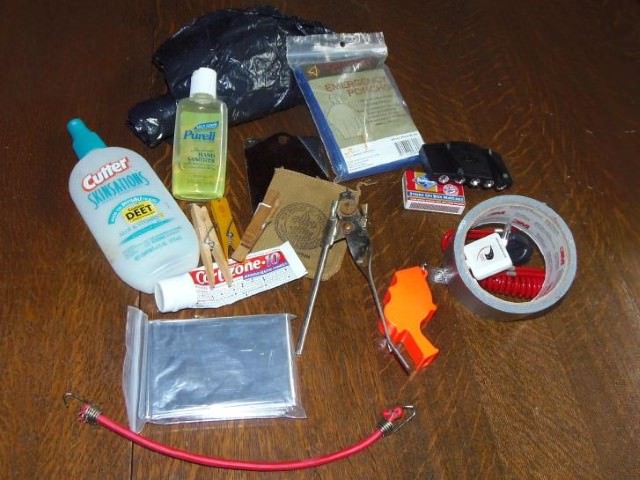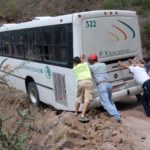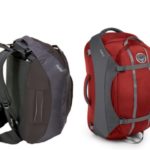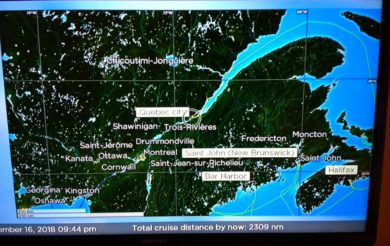Part 1: Travel Tips: Emergency Situations
Part 1: Travel Tips: Emergency Situations
By Jeannette and Dan Dudek
Emergency Preparation for Staying or Evacuating
An evacuation order requires you to immediately travel; are you prepared for doing so? Recently Hurricane Sandy devastated the northeast United States, causing as much as $60 Billion dollars in damage; plus the loss of lives of at least 50 people. In addition, countless individuals will suffer physical and emotional damage before the complete tally of this event has been completed.
At any time, at any place, nature can cause an unpredictable situation that can dramatically affect you and your loved ones. You need to be prepared! This article covers the basics that you must be aware of to ensure your safety during the most common emergency situations; and items you should consider taking with you when you must evacuate.
Power Outages – Electric
Losing power is always an inconvenience, but for some it can be a very dangerous situation. Most power outages in the U.S. do not last more than a couple of hours. However, a severe winter storm, earthquake, hurricane, flood, etc. can put large numbers of homes without power for days or even weeks. Outages can be prolonged in an area if trees fall on power lines and/or transformers explode during an event; or if areas remain flooded preventing utility crews from working in such areas.
If you, or any member of your family, rely on medical appliances or related devices such as: Oxygen Machine, CPAC Machine, Chair Lifts, etc. you need to plan ahead as to how you are going to cope with any extended power outage. If you or any members of your family depend on electric devices to sustain life, you need to contact your local authorities to determine the appropriate course of action if your home loses electrical power.
Portable Uninterrupted Power Supply (UPS) devices may work for some applications. However, the ones designed for PCs that cost under $50 usually only supply power for a few minutes. Unless you are willing to put out large dollars for a more powerful unit, a UPS device is probably not the solution you require.
Be aware that power outages can cause disorientation in older people. Just providing power via a generator for lights, TV and refrigeration can substantially help older people cope with loss of electrical power for a number of days. (It helps the rest of us cope much better as well!)
If the house’s hot water unit is electric, the simple ability to take a hot shower is also a real benefit a gas generator can provide (see below). Note: although we are not located in an area subject to hurricanes, we were hit hard by Hurricane Hugo in 1989. When we built our new house a few years later, we installed two water heaters to service different levels of the house; and we insisted at least one of them be a gas water heater so we would have hot water in most emergency situations. We suggest you consider this option.
Thus a gas-powered generator may be your best alternative for remaining in your home during a period without power. If you decide to obtain a generator, be sure you know how to use it; how to maintain it; and how you intend to supply power to your critical appliances. You may just want to keep a supply of Outdoor/Indoor rated extension cords that are of sufficient length and gauge (at least 16 gauge, 14 gauge is better) to attach to your generator (which must be placed outdoors when running).
An alternative to using extension cords requires you have a certified and licensed electrician install the appropriate electrical wiring, cables and plug to allow you to “back feed” the power from your generator to your house’s main power supply. If you do have installed the electrical components to back feed power to your house’s main electrical supply, be sure you know the exact procedures to safely start and stop this supply of power. Prepare a checklist of the steps, and use the checklist for CONNECTING and DISCONNECTING power to the house system. Failure to do so can cause serious damage to your electrical devices, and cause very serious injury to yourself and/or utility personnel working in your area. (This is why you must have a back feed system installed or inspected by a certified electrician.)
Prepare for an Electrical Outage by:
- Having flashlights and extra batteries readily available. Having candles and matches (using a mirror can increase output).
- Consider using a Generator:
- If you have an RV or Camper with a generator, you can run extension cords from it to critical appliances in your house.
- If you have appropriate equipment on your RV/Camper’s generator, you may be able to “back feed” power to your house’s Main Electric Panel. (The same may apply if you have a standalone generator.)
Note: You have to be careful if you back feed power to your Main Electrical Box. First, turn OFF the Main Breaker(s) usually located at the bottom of the box. Turn OFF all individual circuit breakers. Start your generator, and plug it into the appropriate designated receptacle. Turn ON the circuit breakers that control the appliances/lights/outlets in the house you require—Check with a licensed electrician to plan this procedure, and to ensure you have what is required to do the back feed safely. It is critical you disconnect the power from the generator before you turn on the Main Circuit Breaker(s) or you could possibly severely injure utility personnel working on the lines in your area.
Note: If you do have a generator, be sure to keep a fresh supply of gas and oil for it on hand. Generators should be run for about 15 minutes every few months for good maintenance.
Gasoline
If your area loses electrical power, most likely the gas stations in your area will not be able to pump gas. Do NOT panic! In most cases, you will not be able to drive anywhere; so consider hunkering down at your house. Driving around trying to find gas or waiting in line for hours to hopefully get gas before the station runs out is usually not productive.
Here are few things we recommend:
- Always fill your vehicles with gas when they get to the ¼ level
- Fill all your vehicles with gas if a storm is predicted
- If you have an RV with a built-in generator, keep the RV completely filled with gas as most RV generators will only operate when the gas tank is above ¼
- Be sure to use a gas stabilizer in your RV tank; or any tank that will hold gas for a period of time
- Keep a few gas containers filled and stored in an appropriate place; keep the gas fresh by using and then replacing it
Power Outages – Water and Food
- Have some water stockpiled:
- Buy some bottled water and keep it sealed for drinking.
- Store tap water in appropriate containers for general use.
- Store water purification tablets (check to be sure they have not expired)
- Understand that most healthy individuals can survive three weeks without eating, but only three days without drinking; stock piling water is critical.
Note: You can boil water to make it safe to drink; you only need to bring the water to a rolling boil, i.e. you do not have to boil it for minutes as you may have heard.
(In an emergency, you can fill a paper cup with water and place it directly on a wood fire. The water will come to a boil and the cup will not burn.)
Note: Do not eat snow as a substitute for water. Eating snow will cause your core body temperature to drop, making you subject to hyperthermia, a life-threatening condition. Snow can be melted with a stove or fire and then the warmer water can be drunk safely.
- Maintain a supply of non-perishable food, including some canned items (and a non-electric can opener); and dehydrated food.
- Be sure you have a gas or charcoal grill, or wood stock, to allow for cooking.
- Keep the gas container filled and/or charcoal and starter fluid available.
- If you do not have a gas powered generator (see below), keep several blocks of ice tightly wrapped (or in sealed plastic containers) in your freezer. Having an extra refrigerator or freezer is worth the investment if you live in an area prone to power outages. Having blocks of ice can help keep your perishable food safe to eat for several days.
Note: After several days without electric, the “panic” tends to set-in. This occurs as you realize you have eaten your refrigerated food; and the food in your freezer is defrosting. Try the best you can to move the most frozen items to small coolers and pack them tightly; and store the coolers in a cold or cool place. Then start cooking the defrosting items. Having been through this situation, we do not recommend you get in your car and start searching for ice. You will most likely not be able to find any. Instead, take stock of what food you have, and plan on how you will cook and eat it. If you are unsure if any food item is “good”, do NOT take any chances; throw it out.
Power Outages – Heat
- Have approved indoor rated non-electric heaters available.
- Wear extra layers of clothing and a hat to conserve body heat.
- Use gas fireplaces and know how to start them without using an electrical starter.
- If you have wood burning fireplaces, keep them clean and have a supply of firewood, kindling and fire starter logs.
Note: If your only firewood is wet, split it to expose the dryer inside. You can buy an inexpensive wood splitter that is about eight inches long to make this job a lot easier. You place the point of the splitter in the log, and hit the splitter’s wide end with a sledgehammer. This is safer than using an axe or other similar tool. To start the fire, have kindling available, or you can use a few pieces of newspaper rolled up tightly. You can use a sharp knife to “shave” off pieces of wood from a dry log to make kindling as well. Another method is to soak some wine corks in rubbing alcohol for a half-hour or so. These corks can then be used as fire starters.
Note: For outdoor use, you can use an appropriate flammable liquid fire-starting product (NEVER USE GASOLINE). Use such products only if you do not intend to use the fire for the immediate preparation of food. NEVER, NEVER use such products directly on the wood in the fire pit once the fire has started. The fire can travel back up the stream of liquid and ignite the liquid in the can—this can result in an explosion and cause very severe injury and even death to anyone holding the can or nearby. Once a fire is started, add small pieces of wood, or shavings of wood, and fan the fire to accelerate the burning.
Note: Do not burn any pressure treated wood in your fireplace. Pressure treated wood can give off dangerous gases that could be fatal. Likewise, do not burn any twigs that might be from poisonous plants, such as Poison Ivy. Breathing the fumes from such plant material could infect a person’s eyes, skin and airway and result in a serious condition; an infection of the airway can be fatal without medical help.
Note: Never leave a fire unattended and be sure you extinguish it before going to bed. Always have some filled water containers nearby when using a fire.
Power Outages – Emergency Items
- Extra Cash—some amount you deem appropriate should be stored in your home, preferably in your home’s in-wall safe; during power outages banks may not be able to open and ATMs may not be operational.
- Extra supply of prescription drugs—it is suggested that you maintain at least one week’s supply of all required prescription drugs; again, best to keep these in your in-wall safe. (Pharmacies may not be able to open or process orders during an extended and extreme power outage.)
Note: When a power outage extends more than a couple of hours, check on your elderly neighbors to be sure they are okay. If you have a generator, consider running one extension line to their house so they can have some light and be able to use their television.
Flooding
- Do not drive your vehicle into flooded road areas; as little as six inches of water can cause a car to stall.
- Do not drive over any bridges that are underwater; the bridge may have damage you cannot see, or be weakened so it cannot support the weight of a car.
- A foot of water can “float” many types of cars and most cars can be floated or swept away in 18 inches of moving water.
- If your vehicle is pushed into deeper water, be aware that it may well tip over on its side; be prepared to exit the vehicle immediately (if you do exit, stay on top of your vehicle if possible and wait for help).
- If you and your vehicle are going to go underwater, get out ASAP; open a door or window if you still have power; if you cannot, use an emergency tool to break the window.
- If your vehicle does completely submerge, do not panic, there will be some air trapped in the vehicle as it fills with water; once there is enough water in the vehicle to neutralize the water pressure from the outside, you will be able to open the door and escape.
- If you are swept away by rushing water, put your body in a position where you are on your back with your legs extended in the direction you are being pushed; use your feet to ward off debris and keep you from being slammed into rocks or other obstacles.
- Do not attempt to walk across a flooded area or road; manhole and drainage covers may be displaced and you could easily fall into a deep drain and drown; if in an emergency you must walk across a flooded area, wear a life preserver and carry a long pole horizontally to help prevent falling into an uncovered storm drain.
- Flooding may have forced dangerous animals and poisonous snakes out of their territory, be vigilant.
- Treat all cuts immediately with disinfectant wipes, wash with soap and water, apply disinfectant cream and bandage appropriately; bacteria and sewage will probably be in flooded areas.
Emergency Departure
If your local authorities request or mandate an evacuation of your area, do so IMMEDIATELY! Time is of the essence. If you wait too long, you may be caught in traffic jams, or the evacuation routes may become unusable.
In some emergency situations, your home may be in danger due to fire, storms, floods, mud slides, earthquakes, etc. In this situation, you and your family need to leave the house within minutes, and if separated, know where to meet. Consider taking the following:
- Bug-Out Bag—it should be a fully packed duffel size bag that contains the essentials for surviving outdoors for at least several days. Items should include: first aid kit, flashlights, candles, small mirror, change of clothes, compact hygiene items, toilet paper, small plastic bottle of Woolite (or similar cleaner), power bars, extra batteries, small radio (possibly one that can be hand cranked for power), whistle, pocket knife, bug repellent, multi-purpose tool, ponchos, wool or thin emergency blankets, sweater, wind breaker, water purification tablets, small camp stove (and its fuel), compass, matches, a roll of fishing line, several size fish hooks, a few safety pins, non-perishable food (including high-energy bars) (enough for several days), non-electric can opener and plenty of water.
- Large plastic bags can serve many purposes, so pack a few. These bags can be used in a temporary outdoor structure in the roof to reduce rain from coming into the structure; you can use them as a ground cloth to keep the dampness of the earth from getting to you as you sit and sleep; and they can be used as a shirt next to your skin to keep the trunk of your body (and its vital organs) warm in the coldest conditions.
Other items to include in a Bug Out bag shown above are: emergency high efficiency blanket; duct tape; clothes pins, whistle; bug repellant, anti-itch cream; mirror; matches, disinfectant; large plastic bag; etc.
Be prepared to add to your Bug-Out bag:
- Prescription drugs and items from your in-wall safe mentioned above, i.e. cash, insurance documents, passports, wills, birth certificates, living wills, health care power of attorney, valuables, etc.
- Consider including binoculars, night vision devices, GPS units, and other such devices.
- If you are a gun owner, you will probably want to add your gun and/or rifle, ammunition and cleaning kit. (Be sure to transport all firearms in accordance with state laws.)
- Do not forget to pack items such as cell phones, cell phone charger, laptop/notebook PC and/or your backup external drive or backup disks/thumb drives for your desktop PC.
Note: Consider using your camping backpack as your Bug-Out bag. (If you do not have a backpack, you can pick up a used one very inexpensively.) Having a large pack that you can wear on your back will help if you have to walk with it for any distance for any reason. In addition, the various pockets on such packs will make it easier for you to organize and be able to quickly retrieve your items. While you are at it, you might as well include your sleeping bag and sleeping mat in your Bug-Out bag. With these items, you should be able to sleep well in a shelter that runs out of cots for sleeping; the floor at a friend’s house; or even in the great outdoors if necessary.
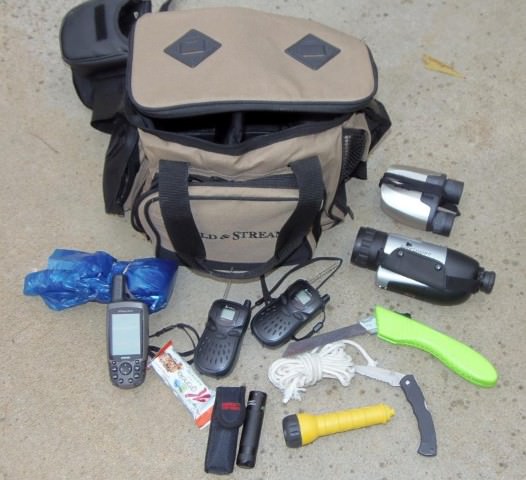
Example of a Bug Out bag with some emergency items, including a hand-held GPS unit, 2-way radios, binoculars, night vision scope, poncho, energy bar, two small flashlights, knife, collapsible saw, and some rope.
Miscellaneous:
- Meeting Location—since it is possible all of your immediate family will not be at home when an emergency departure is required, you should have a predetermined meeting place. Do not rely on cell phones to work to coordinate getting together. You should plan two separate locations in case one of the locations is inaccessible.
- Pets—if you have to leave your pet at a pet shelter, call the shelter to make a reservation as soon as possible to ensure a space; you will most likely need to bring a cage, documentation for all required shots, rabies tag, and medications – call beforehand and talk to someone about the specific items for your location.
- Chainsaws – after many disastrous nature events, trees will be down. Insurance firms will typically pay to have any tree that is leaning against a house cut and removed. Other downed trees are the responsibility of the owner to have cut and removed; and private contractors can charge quite a bit for doing so. If you elect to use a chainsaw to cut the downed trees yourself, be extremely careful. We recommend you use a “banana” tip shaped chainsaw to reduce “kickback”; wear leather gloves, steel tipped safety shoes, safety glasses and a hard hat. Never use a chainsaw on a ladder; get the professionals involved for this situation.
Author’s Comment:
Hurricane Hugo downed dozens of trees on our two properties. Dan purchased a “banana” tipped chainsaw, read all the directions, used leather gloves, wore steel tipped safety shoes, safety glasses and a hard hat. After four weeks of cutting and moving logs to the street for the authorities to pick-up, he was very familiar with using the chainsaw; was always careful; and always stopped as soon as he got tired. The very last thing to cut was a large limb that was ½ broken and extending from a tree to the ground. The problem was that an extension ladder was needed to reach where the limb was partially attached to the tree; in order to make the required cut. Dan studied the limb and envisioned how it would react if cut, i.e. he knew from his recent cutting experiences that limbs can be under tension, and when cut move quickly in one direction or another. With one hand holding the tree for support, and the other hand operating the chainsaw, Dan carefully cut the limb. As soon as the limb was completely cut and free, the tension was released and the limb did jump – only in a direction Dan had not anticipated! In the split second the limb jumped, it somehow caught the still running chainsaw and bounced it off of Dan’s hard hat! The hard hat saved his life. If Dan was using two hands on the chainsaw, he probably could have controlled it, but on the ladder this was not possible. We have since purchased an electric chainsaw that attaches to a pole for cutting anything above shoulder height – we strongly recommend you do the same or hire a professional.
Tornados
According to the Federal Emergency Management Agency (FEMA), now part of the U.S. Department of Homeland Security (DHS), if you are under a tornado WARNING, seek shelter immediately!
|
If you are in: |
Then: |
| A structure (e.g. residence, small building, school, nursing home, hospital, factory, shopping center, high-rise building) | Go to a pre-designated shelter area such as a safe room, basement, storm cellar, or the lowest building level. If there is no basement, go to the center of an interior room on the lowest level (closet, interior hallway) away from corners, windows, doors, and outside walls. Put as many walls as possible between you and the outside. Get under a sturdy table and use your arms to protect your head and neck. Do not open windows. |
| A vehicle, trailer, or mobile home | Get out immediately and go to the lowest floor of a sturdy, nearby building or a storm shelter. Mobile homes, even if tied down, offer little protection from tornadoes. |
| The outside with no shelter | Lie flat in a nearby ditch or depression and cover your head with your hands. Be aware of the potential for flooding. Do not get under an overpass or bridge. You are safer in a low, flat location. Never try to outrun a tornado in urban or congested areas in a car or truck. Instead, leave the vehicle immediately for safe shelter. Watch out for flying debris. Flying debris from tornadoes causes most fatalities and injuries. |
Read More in Jeannette and Dan Dudek’s Travel Tips Safety Series
- Part 2: RVing and Camping Safety – Things You Should Know When Your Travels Involve Camping and Hiking
- Part 3: Outdoor Safety Items – What Everyone Needs to Know About Outdoor Safety
Bio:
Although 100 miles from the ocean Jeannette and Dan Dudek were without electric at their home in North Carolina for fourteen days after Hurricane Hugo ripped thought South Carolina and North Carolina in 1989. Jeannette and Danhave traveled extensively domestically and internationally; and have been to most U.S. states and Canadian provinces and about 30 countries.
Besides international travel, Jeannette and Dan enjoy traveling North America in their RV, as well as handgun competitions, sailing, hunting, hiking, mountain biking and other outdoor sports.

